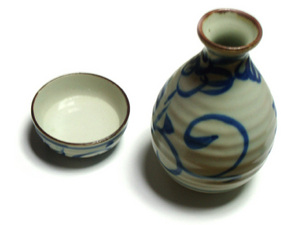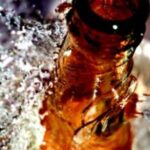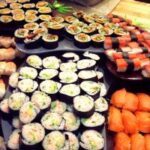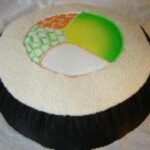With sushi bars and Japanese steakhouses being so popular this decade, more than likely sake has been sipped on occasion while dining at these trendy Japanese restaurants. If you love Japanese cuisine and enjoy drinking warm or hot sake on a cold winter’s night or cold sake during those long hot summer days this will be the perfect list for you. For those not familiar with sake it is very simply, a rice wine. It is brewed, not fermented like true wine, but more akin to beer’s processing system. Whereas with wine the alcohol content is generally 9-16%, beer is at 3-8%, undiluted sake at 18-20% and diluted sake is at 15%. In other words, there is a lot of alcohol content in sake. It is very strong when you first taste it. During the Asuka period from 538 to 710 in Japan that is when sake was brewed at temples and shrines. In present day you’ll find dedicated sake barrels or kegs made of wood stored at Shinto shrines that will be used for a number of festive occasions.
It is difficult to say what the best sake is when everyone has different tastes. Sake comes in many forms for a variety of uses and occasions. John Gautner, an American who lives in Japan, is the foremost leading non-Japanese expert on sake. He has written countless articles for Japanese and American publications on this topic. His website SakeWorld.com has everything you ever want to know about sake. He has devised a system on the most popular Japanese sake and the largest brewers in Japan as well as globally. However, I have lived in Japan and know a thing or two about sake myself. It can be purchased in Japan at convenient stores, grocery stores, and specially designated shops. I have seen sake sold at grocery stores and wine/liquor stores in the U.S. The list will be broken down into two sections, one for the extremely popular sake and the other for the largest brewers. This way it should please as many sake connoisseurs as possible
Popular Sake
In no particular order is the list of the five popular sakes, along with individual tasting notes and the prefecture (state or province) it is harvested and brewed from. There are two types of sakes that are produced. The first being the equivalent of a table wine. This is your commonly purchased sake. The other is the “special designation sake”, which is a pure sake brewed in premium form.
1. Juyondai – This sake is in such demand they cannot keep it on the shelf long enough in both the U.S. and Japan. It is considered one of the best ever made and comes from a legendary brewery. Juyondai is aged sake that has been set aside for three years to age or “develop”. The nose of this sake is fruity that is full of ripe dried fruits, caramel, subtle vanilla, and steamed rice. When you first sip this elegant sake it doesn’t just enter the mouth it oozes. A wonderful food pairing would be with crab. Yamagata Prefecture is where this sake comes from. Yamagata is also known for being the largest producer of cherries and pears in Japan.
2. Michizakari – The brewery in Gifu has been known for its very dry and clean sake long before sake became globally popular a couple of decades ago. Its flavor is light and dry, yet full of flavor. Slightly oily food or light meat would go good with this sake when it is slightly warmed.. Unfortunately Michizakari sake is not available in the U.S. Gifu Prefecture is ideal for brewing sake, because of the clear water from the rivers.
3. Urakasumi – Their sake brewery dates back to the time of feudal lords over 280 years ago. It is one of the leading local sake breweries in the northeastern region of Japan in Miyagi Prefecture near Matushima Bay in Shiogama. They use locally grown rice to make their sake under the skillful Nanbu toji, a master brewer. Many have described Urakasumi sake as dreamy that’s settled and balanced in overall taste. This is sake made with a labor of love.
4. Kokuryu – From Fukui Prefecture that faces the Sea of Japan, and home to a serene temple training Buddhist monks, is their popular sake noted for being earthly, balanced, and rich. Its taste is smooth, sleek, deep, and delicious. Due to its high alcohol content don’t drink this sake too cold. Room temperature is the best to serve Kokuryu sake.
5. Denshu – From the northern tip of Honshu, the largest island in Japan, and in the snowiest region n Japan, more so than the northern island of Hokkaido, comes one of the best sakes from Aomori Prefecture. Sometimes a location with marginal growing areas produce the best crops or in this case, sake. It has been said Denshu sake is actually handmade. Whatever is the case you’ll find aromas of fresh cream, peach, white chocolate, and orange pith. There are also fresh fruits of peach and apricot. It has a hefty alcohol content of 17%. Your first sip will be smooth and end with a long creamy finish.
The Largest Brewers of Sake
Even though these are the largest ones in Japan that mass-produce inexpensive sake they still are good solid companies as you will find out later on. These are very skilled brewers who make outstanding sake. One of them is my favorite sake of all.
1. Hakutsuru – They are the #1 sake in Japan with their brewery in Hyogo Prefecture, which is where I use to live, more specifically in the city of Himeji, where the famous castle is. The capital of Hyogo, Kobe, houses the Hakatsuru Sake Brewery Museum where you can take a tour. My favorite product of this brewery is their Sayuri Nigori Sake that is coarse-filtered. Overall, their sake is solid, straightforward, and clean. That is truly the making of a fine sake.
2. Sawanotsuru – Using only the finest quality of brewing rice, pure water from Miya’s natural spring water source that comes from rain falling off the Rokko Mountains in Hyogo Prefecture, and traditional brewing methods under the watchful eye of a mater brewer results in their ultimate sake that is full, flavorful, and direct. This outstanding Japanese Sake is sold all over the world.
3. Ozeki – Here is an interesting story about this sake brewery in Nada, Hyogo Prefecture (between Osaka and Kobe). They are the first major sake brewer to begin production in the U.S. thirty years ago in Hollister, CA. Ozeki has been brewing sake in Japan for 291 years. The name of this brewery is rooted in the Japanese sport of sumo wrestling. Every year they present the Ozeki Cup to victorious sumo wrestlers who drink their sake out of a silver cup, much like the victorious Indy race car drivers drink milk from the old-fashioned glass bottle. However, they offer a variety of sake products that’s fragrance and taste are lively and solid. They use water from the Sierra Nevada Mountains and rice from nearby Sacramento.
4. Shochikubai – It is the best-selling sake in the U.S., because of its high quality and superior taste that made it America’s favorite sake. The Sho Chiku Bai Classic is their most traditional styled sake just like the prefecture it comes from, Kyoto, which is steeped in traditional Japanese culture and history. This sake is perfectly paired with mildly seasoned dishes. You’ll find it has a smooth, well-balanced, and full body that is a dry/sweet combination. The texture is hard and crisp with the aroma being mild, but complex. Its alcohol content is at 15%. For the best results serve the sake at room temperature or warm for a superb dining experience.
5. Gekkeikan – Founded in 1637 they are one of the world’s oldest companies. Based in Fushimi, Kyoto, Japan they have a U.S. subsidiary in Folsom, California. Folsom’s location was ideal due to their high quality of water and abundance of rice that is harvested in California. All of their sake products are known for being soft, yet complex overall. This is sake I am very familiar with. It is sold quite extensively in the part of Japan I lived in, since I resided in the Kansai region where Hyogo and Kyoto Prefectures are located. It does have a soft texture when tasting. This is my favorite sake of all. Naturally it is the best sake of the decade. I highly recommend it to all lovers of sake.
As you can see the first five sakes are primarily sold in Japan that are traditionally made from their specific regions. The second half of the remaining five sakes are mostly sold or manufactured in the U.S. utilizing traditional Japanese brewing methods and state-of-the-art high technology equipment. Either way these are all outstanding sakes of the decade worth looking into.
SOURCES:
http://en.wikipedia.org/wiki/Main_Page
http://www.sake-world.com/html/best-sake-picks.html
http://www.truesake.com/newsletters/2006-01.php
http://www.urakasumi.com/hpa/english.html
http://www.vinography.com/archives/2009/06/denshu_hyakuyonju_junmai_daigi.html





